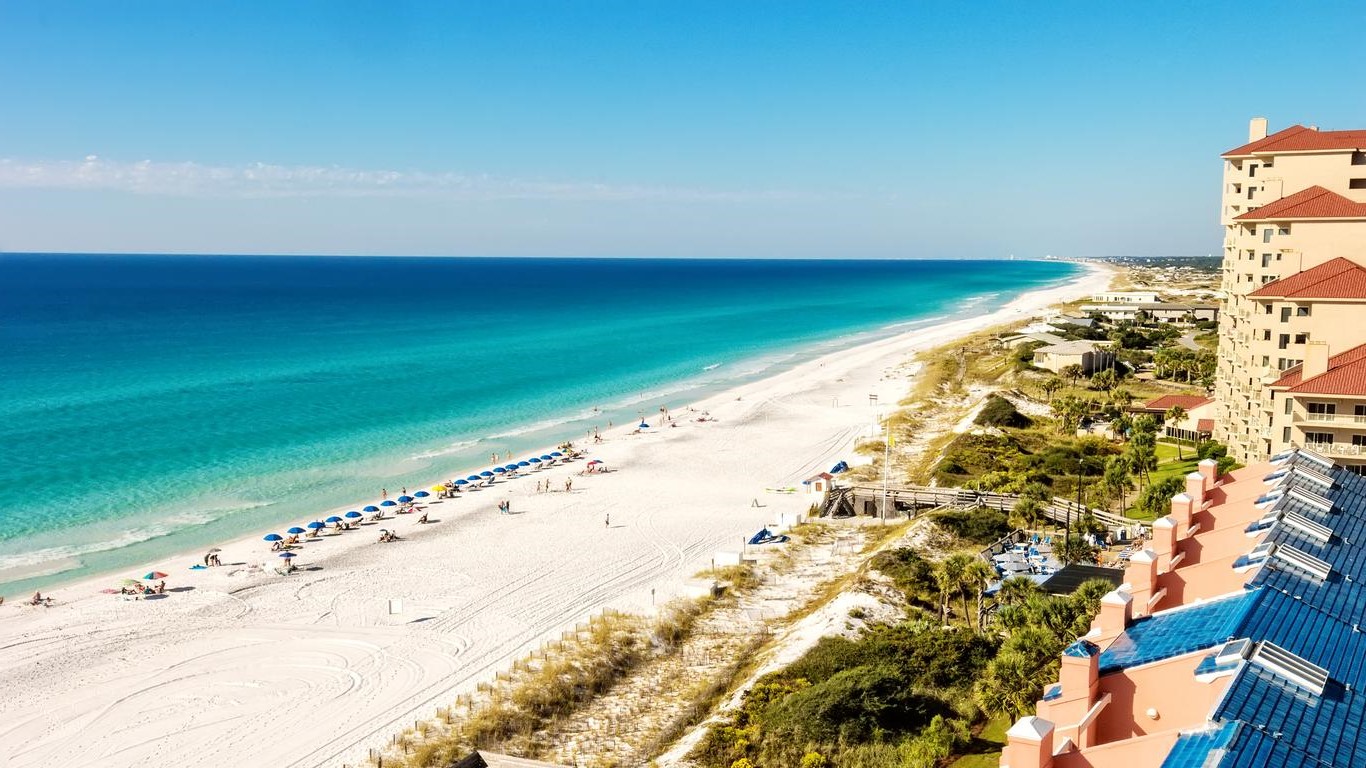Home>Weather and Climate>Naples Florida Climate: A Comprehensive Guide To Weather And Climate In Naples


Weather and Climate
Naples Florida Climate: A Comprehensive Guide To Weather And Climate In Naples
Published: April 11, 2024
Discover the weather and climate in Naples, Florida with our comprehensive guide. Plan your visit with insights on temperatures, rainfall, and seasonal variations.
(Many of the links in this article redirect to a specific reviewed product. Your purchase of these products through affiliate links helps to generate commission for Temperatures.com, at no extra cost. Learn more)
Table of Contents
Introduction
Welcome to the vibrant city of Naples, Florida, where the sun-kissed beaches, lush greenery, and inviting climate create an idyllic setting for residents and visitors alike. Nestled along the Gulf of Mexico, Naples boasts a unique microclimate that beckons outdoor enthusiasts, nature lovers, and sun-seekers year-round. In this comprehensive guide, we will delve into the captivating world of Naples Florida climate, exploring its diverse weather patterns, seasonal nuances, and the impact of climate change on this coastal paradise.
As we embark on this journey through Naples' climate, we will unravel the intricate tapestry of meteorological phenomena that shape the region's atmospheric dynamics. From the balmy embrace of summer to the refreshing coolness of winter, Naples' climate embodies a harmonious blend of warmth, sunshine, and occasional tropical influences. Our exploration will illuminate the nuances of this captivating climate, offering insights into the factors that make Naples a haven for those in pursuit of a quintessential coastal experience.
Join us as we unravel the mysteries of Naples Florida climate, where the ebb and flow of the tides mirror the ever-changing dance of the elements. Through this exploration, you will gain a deeper understanding of the atmospheric forces that bestow Naples with its distinctive character, beckoning all who revel in the embrace of nature's boundless beauty. Let's embark on this enlightening journey to uncover the secrets of Naples' climate and gain a newfound appreciation for the captivating interplay of weather and environment in this enchanting coastal haven.
Understanding Naples Florida Climate
Naples, Florida, is renowned for its delightful subtropical climate, characterized by an abundance of sunshine, balmy temperatures, and refreshing sea breezes. This coastal paradise experiences a unique microclimate that sets it apart from other regions, creating an inviting environment for residents and visitors alike. The climate of Naples is influenced by its proximity to the Gulf of Mexico, which moderates temperatures and contributes to the region's distinctive weather patterns.
The city experiences a delightful blend of warm, sunny days and mild, comfortable evenings throughout much of the year. The subtropical climate of Naples is defined by its distinct wet and dry seasons, each contributing to the region's overall atmospheric tapestry. The prevalence of sunshine and relatively low humidity levels make Naples an appealing destination for those seeking an escape from harsher climates.
The gentle embrace of Naples' climate is further enhanced by the soothing sea breezes that waft across the coastline, offering respite from the warmth of the sun. This interplay of coastal influences and subtropical characteristics creates a harmonious balance that shapes the overall climate of Naples, fostering an environment that is conducive to outdoor activities, leisurely strolls along the beach, and al fresco dining experiences.
Understanding the nuances of Naples Florida climate involves appreciating the interplay of various factors, including sea surface temperatures, prevailing winds, and the influence of tropical weather systems. These elements converge to create a climate that is synonymous with relaxation, recreation, and a deep connection to the natural world. Whether basking in the golden glow of a sun-drenched afternoon or savoring the tranquility of a balmy evening, Naples' climate beckons all to embrace the beauty of coastal living.
In the following sections, we will delve deeper into the specific aspects of Naples' climate, exploring average temperatures, seasonal weather patterns, rainfall, humidity, and the impact of climate change on this captivating region. By unraveling the intricacies of Naples Florida climate, we gain a profound appreciation for the atmospheric symphony that unfolds against the backdrop of this coastal paradise.
Average Temperatures in Naples
Naples, Florida, is synonymous with delightful subtropical temperatures that beckon residents and visitors to revel in the warmth of the sun and the gentle caress of coastal breezes. The city's climate is characterized by its year-round appeal, offering a harmonious blend of balmy days and comfortable evenings. Understanding the average temperatures in Naples provides valuable insights into the region's atmospheric dynamics and the allure of its climate.
During the winter months, Naples experiences mild and pleasant temperatures, with average highs ranging from the upper 70s to low 80s Fahrenheit (25-28°C). This temperate climate creates an inviting environment for outdoor activities, leisurely walks, and al fresco dining experiences. The winter evenings bring a touch of coolness, with average lows in the 50s to low 60s Fahrenheit (10-16°C), allowing residents and visitors to savor the refreshing coastal air.
As spring unfolds, Naples transitions into a phase of gradual warming, with average temperatures climbing to the mid to upper 80s Fahrenheit (29-31°C). The city becomes adorned with vibrant blooms and lush greenery, creating a picturesque backdrop for outdoor pursuits and nature-inspired adventures. The springtime warmth infuses the air with a sense of vitality, inviting individuals to embrace the rejuvenating embrace of Naples' climate.
Summer heralds the arrival of warmer temperatures, with average highs reaching the low to mid-90s Fahrenheit (32-35°C). The sun-drenched days offer ample opportunities for beach outings, water sports, and leisurely sunbathing, as Naples' climate embraces the essence of a quintessential coastal summer. The evenings maintain a pleasant warmth, with average lows in the 70s Fahrenheit (21-26°C), fostering an ambiance that is conducive to outdoor gatherings and evening strolls along the waterfront.
As autumn unfolds, Naples experiences a gradual cooling, with average temperatures easing back to the mid to upper 80s Fahrenheit (29-31°C). The city's surroundings take on a golden hue as the foliage begins its seasonal transformation, creating a captivating tapestry of colors that harmonize with the gentle warmth of the autumn climate. The comfortable temperatures of autumn beckon residents and visitors to savor the outdoor splendors of Naples, from scenic nature trails to waterfront dining experiences.
The year-round average temperatures in Naples reflect a climate that is synonymous with comfort, relaxation, and a deep connection to the natural world. Whether basking in the gentle warmth of a winter afternoon or savoring the balmy embrace of a summer evening, Naples' temperatures encapsulate the essence of coastal living, inviting all to embrace the beauty of this captivating region.
Seasonal Weather Patterns
Naples, Florida, boasts a captivating array of seasonal weather patterns that define the ebb and flow of its climate throughout the year. From the gentle embrace of winter to the sun-drenched days of summer, each season brings its own distinct atmospheric tapestry, shaping the experiences of residents and visitors alike.
Winter in Naples unfolds with mild temperatures and a delightful ambiance that beckons individuals to savor the coastal charm. The season is characterized by comfortably cool evenings and pleasantly warm days, with average temperatures ranging from the upper 70s to low 80s Fahrenheit (25-28°C). The winter weather sets the stage for outdoor pursuits, leisurely walks along the beach, and al fresco dining experiences, creating an inviting environment for those seeking respite from colder climates.
Spring heralds the arrival of rejuvenation and vitality, as Naples awakens to the vibrant blooms and lush greenery that adorn its landscape. The season brings a gradual warming, with average temperatures climbing to the mid to upper 80s Fahrenheit (29-31°C). The air becomes infused with a sense of renewal, inviting residents and visitors to immerse themselves in the natural splendor of Naples, from scenic nature trails to waterfront promenades.
Summer in Naples embodies the quintessential coastal experience, with sun-drenched days and balmy evenings that epitomize the allure of a subtropical climate. The season unfolds with average highs reaching the low to mid-90s Fahrenheit (32-35°C), creating an ideal setting for beach outings, water sports, and leisurely sunbathing. The evenings maintain a pleasant warmth, fostering an ambiance that is conducive to outdoor gatherings and evening strolls along the waterfront.
Autumn graces Naples with a gradual cooling, as the temperatures ease back to the mid to upper 80s Fahrenheit (29-31°C). The season paints the city and its surroundings with a golden hue, as the foliage undergoes its seasonal transformation, creating a captivating tapestry of colors that harmonize with the gentle warmth of the autumn climate. Residents and visitors alike are invited to savor the outdoor splendors of Naples, from scenic nature trails to waterfront dining experiences.
These seasonal weather patterns weave a captivating narrative of Naples' climate, offering a diverse tapestry of experiences that celebrate the beauty of each season. Whether reveling in the tranquility of a winter evening or embracing the vitality of a spring afternoon, Naples' seasonal weather patterns invite all to immerse themselves in the ever-changing symphony of nature's elements.
Rainfall and Humidity
Naples, Florida, experiences distinct rainfall and humidity patterns that contribute to the region's overall climate dynamics. Understanding the interplay between rainfall and humidity provides valuable insights into the atmospheric nuances that shape Naples' environment.
The city's annual rainfall is characterized by a bimodal distribution, with distinct wet and dry seasons. The wet season typically spans from June to September, coinciding with the peak of the Atlantic hurricane season. During this period, Naples receives the majority of its annual rainfall, with frequent afternoon thunderstorms and occasional tropical systems contributing to the precipitation. The lush vegetation and vibrant flora of Naples owe much of their vitality to the nourishing rains of the wet season, creating a picturesque landscape that captivates residents and visitors alike.
In contrast, the dry season, which extends from October to May, brings a noticeable reduction in rainfall, with clear skies and lower humidity levels prevailing. This period of diminished precipitation allows for an abundance of outdoor activities, from leisurely beach outings to exploring the city's natural wonders. The dry season's inviting climate and limited rainfall make it an ideal time for residents and visitors to immerse themselves in the myriad recreational opportunities that Naples has to offer.
Humidity plays a significant role in shaping the overall comfort of Naples' climate. The city experiences higher humidity levels during the wet season, contributing to a tropical ambiance characterized by warm, moist air. Despite the elevated humidity, the coastal location of Naples allows for refreshing sea breezes to mitigate the effects of the moisture-laden air, creating a pleasant environment for outdoor pursuits.
During the dry season, humidity levels decrease, fostering a more comfortable atmosphere that is conducive to outdoor activities and al fresco dining experiences. The combination of lower humidity and abundant sunshine enhances the appeal of Naples' climate, inviting individuals to revel in the region's natural splendor.
The intricate dance between rainfall and humidity in Naples weaves a captivating narrative of the city's climate, offering a balance of nourishing rains and comfortable humidity levels that contribute to the region's overall allure. Whether embracing the refreshing breezes of the wet season or reveling in the comfortable dryness of the winter months, Naples' rainfall and humidity patterns enrich the atmospheric symphony that unfolds against the backdrop of this coastal paradise.
Extreme Weather Events
Naples, Florida, is no stranger to the potential impacts of extreme weather events, particularly during the Atlantic hurricane season. The region's coastal location exposes it to the influence of tropical storms and hurricanes, which can bring significant rainfall, strong winds, and potential storm surge. Understanding the dynamics of extreme weather events is crucial for residents and local authorities to prepare and mitigate the potential risks associated with these phenomena.
The Atlantic hurricane season, which officially spans from June 1st to November 30th, poses the greatest threat of extreme weather events in Naples. During this period, the warm waters of the Gulf of Mexico and the Atlantic Ocean provide the energy necessary for the formation and intensification of tropical storms and hurricanes. These weather systems can bring heavy rainfall, high winds, and, in the case of hurricanes, the potential for storm surge along the coastline.
Naples' preparedness for extreme weather events is essential for safeguarding lives and property. Local authorities and emergency management agencies work diligently to educate residents about hurricane preparedness, evacuation routes, and the importance of having a well-stocked emergency kit. Additionally, building codes and construction practices in Naples are designed to enhance the resilience of structures in the face of strong winds and potential storm impacts.
In recent years, advancements in meteorological technology and forecasting have significantly improved the ability to track and predict the paths of tropical storms and hurricanes. This enhanced capability allows for more accurate and timely warnings, giving residents and authorities ample time to prepare and take necessary precautions.
While extreme weather events pose potential risks, the resilience and preparedness of Naples' residents and local authorities play a crucial role in mitigating the impacts of these phenomena. Through proactive planning, community engagement, and adherence to safety guidelines, Naples continues to fortify its defenses against the potential impacts of extreme weather events, ensuring the well-being and security of its residents.
The city's ability to adapt and respond to extreme weather events reflects a commitment to safeguarding the community and preserving the natural beauty of this coastal paradise. By remaining vigilant and proactive, Naples stands resilient in the face of potential weather challenges, embracing a spirit of preparedness and unity in the pursuit of a safe and secure environment for all who call this vibrant city home.
Climate Change and Naples Florida
The specter of climate change casts a profound shadow over Naples, Florida, as the region grapples with the far-reaching implications of environmental transformation. The coastal paradise of Naples is not immune to the global phenomenon of climate change, which manifests in various ways, from rising sea levels to shifts in weather patterns and the potential for more intense tropical storms.
One of the most pressing concerns related to climate change in Naples is the potential impact on sea levels. As global temperatures rise, polar ice caps and glaciers melt, contributing to the gradual encroachment of rising seas. For a city like Naples, which is intricately intertwined with its coastal environment, the implications of rising sea levels are significant. Low-lying areas, including waterfront properties and natural habitats, face the risk of inundation, posing challenges for urban planning, infrastructure resilience, and the preservation of coastal ecosystems.
In addition to the threat of rising seas, climate change has the potential to influence weather patterns in the region, leading to shifts in precipitation, temperature extremes, and the intensity of tropical weather systems. Naples may experience altered rainfall patterns, with implications for water resources, agriculture, and the overall balance of the local ecosystem. The potential for more intense tropical storms and hurricanes poses a heightened risk to the region, necessitating proactive measures to enhance preparedness and resilience.
The implications of climate change extend beyond environmental concerns, encompassing social, economic, and cultural dimensions. Naples' vibrant community, which thrives on its coastal identity and natural beauty, faces the imperative of adapting to a changing climate while preserving the essence of what makes the region unique. From sustainable urban planning and infrastructure design to community engagement and environmental stewardship, addressing the challenges of climate change requires a multifaceted approach that embraces innovation, collaboration, and a commitment to safeguarding the well-being of current and future generations.
Despite the sobering realities of climate change, Naples is not without hope. The city has the opportunity to lead by example, embracing sustainable practices, environmental conservation, and resilience-building initiatives that serve as a beacon of inspiration for communities facing similar challenges worldwide. By fostering a culture of environmental awareness, embracing renewable energy solutions, and advocating for policies that prioritize climate resilience, Naples can chart a course toward a more sustainable and resilient future.
As Naples navigates the complexities of climate change, the city stands at a pivotal juncture, poised to harness its collective ingenuity and determination to confront the challenges ahead. By acknowledging the realities of a changing climate and embracing a spirit of innovation and unity, Naples can forge a path toward a future where the region's natural beauty, cultural heritage, and coastal allure endure for generations to come.
Conclusion
In conclusion, the captivating allure of Naples, Florida, is intricately woven into the fabric of its climate, which embodies a harmonious blend of warmth, sunshine, and coastal influences. The city's subtropical climate, characterized by its year-round appeal and unique seasonal nuances, creates an inviting environment for residents and visitors to immerse themselves in the natural splendor of this coastal paradise.
From the mild temperatures of winter to the sun-drenched days of summer, Naples' climate offers a diverse tapestry of experiences that celebrate the beauty of each season. The gentle embrace of coastal breezes, the vibrant blooms of spring, and the captivating colors of autumn converge to create an atmospheric symphony that captivates the senses and beckons all to revel in the boundless beauty of nature.
The interplay of rainfall and humidity in Naples adds depth to the region's climate, with nourishing rains during the wet season and comfortable dryness during the winter months. These patterns contribute to the lush vegetation, vibrant flora, and overall allure of Naples' environment, fostering a sense of vitality and tranquility that resonates throughout the city.
While Naples is no stranger to the potential impacts of extreme weather events, the resilience and preparedness of its residents and local authorities play a crucial role in mitigating the effects of tropical storms and hurricanes. Through proactive planning, community engagement, and adherence to safety guidelines, Naples continues to fortify its defenses, ensuring the well-being and security of its residents.
The specter of climate change presents both challenges and opportunities for Naples, as the region navigates the complexities of rising sea levels, shifting weather patterns, and the imperative of sustainability. By embracing sustainable practices, environmental conservation, and resilience-building initiatives, Naples has the potential to lead by example, charting a course toward a more sustainable and resilient future.
As Naples confronts the realities of a changing climate, the city stands poised to harness its collective ingenuity and determination to preserve its natural beauty, cultural heritage, and coastal allure for generations to come. Through a spirit of innovation, unity, and environmental stewardship, Naples can pave the way for a future where the region's captivating climate remains a source of inspiration and wonder for all who are drawn to its shores.














